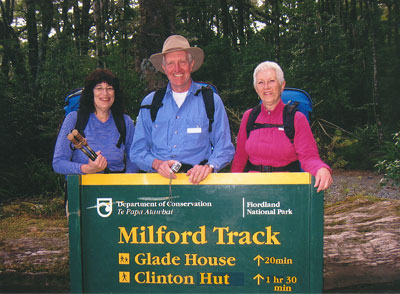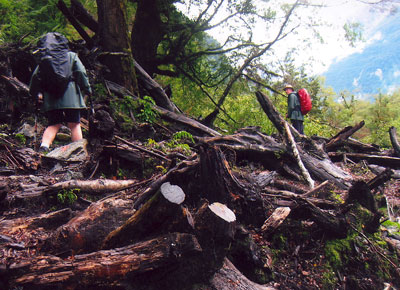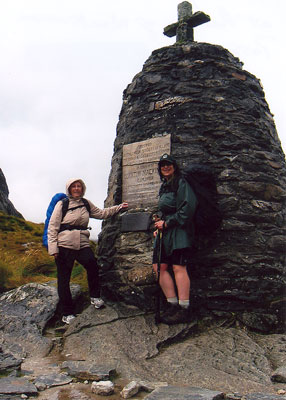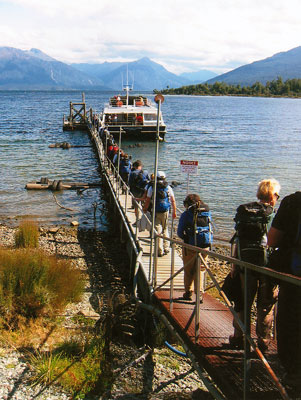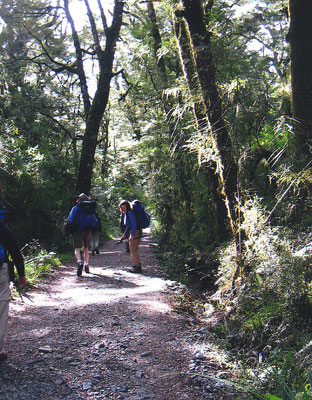Hiking New Zealand’s Milford Track
by Rosemary McDaniel, Trenton, FL
Twenty-two years ago I traveled to New Zealand to hike the Milford Track, located in Fiordland National Park on the South Island. Promoted as the “finest walk in the world,” the 5-day, 4-night walk in the wilderness intrigued me, and I wasn’t disappointed with my experience. I enjoyed it so much that I decided to make the trip again, with my friends Sharon and Marc from New York City, in March 2008.
Impressive improvements
In 1986, guided hikes on the Milford Track and other tracks in Fiordland were operated by the New Zealand government, but now they are operated by Ultimate Hikes (P.O. Box 259, Queenstown 9348, NZ; www.ultimatehikes.co.nz). As in so many other enterprises, the private sector has done a better job than a government entity, and I was amazed by the improvements on this trip.
Communicating with Ultimate Hikes was simple, and my requests for information and reservations were handled efficiently. One of the improvements to the hike is a choice of lodging, their having added en suite rooms with twin or queen beds to the shared, bunk-type rooms holding four to six people.
My friends and I chose the shared accommodations, priced at NZ$1,850 (US$1,426) and we had the rooms to ourselves.
Shared bathrooms with hot showers were only a few steps away from the rooms. There were 43 people in our group, and probably half of them stayed in the en suite rooms, so the shared bathrooms were never crowded.
The three lodges along the route have been dramatically updated with the addition of beautiful lounges and dining rooms. The meals were excellent, and wine, beer and soft drinks were available for purchase.
A dinner menu was provided early so guests could choose the next night’s entrée — meat or fish or vegetarian or vegan fare — so everyone knew what to expect when they arrived at the lodge at the end of the day.
The lodges provided shampoo, conditioner, towels and hair dryers, making backpacks lighter. Towels and blankets were on each bed, and the pillows and mattresses were clean and comfortable.
Getting there
I made my international flight plans through The Travel Team in Seattle, Washington (800/788-0829, www.travelteam.com). I had used them previously to book a flight to Australia and found that they offered excellent fares. The Travel Team only books international flights, so it’s necessary to arrange your own domestic air.
I flew Air New Zealand’s Pacific Premium Economy round trip from Los Angeles to Queenstown for $2,799. This class of service was once their business class, so the seats were more comfortable than those in regular economy. The meals and service were excellent, and the 12½-hour flight to Auckland was comfortable. After a brief layover in Auckland I took the 2-hour flight to Queenstown.
Briefing
On the afternoon prior to our departure for the hike, a mandatory briefing was held at Ultimate Hikes’ headquarters in The Station Building on Queenstown’s Duke Street.
At the briefing, we were given information about the walk and what should be worn for protection from the possibly harsh elements and then introduced to our four guides. Backpacks, sleep sheets and parkas were distributed to those who required them, and we were supplied with large plastic bags that were used as liners in the backpacks. We also chose our dinner entrée for the first night.
Heading out
In the morning, our group met at Ultimate Hikes’ headquarters at 9:00 with our packed backpacks and small bags each with a change of clothes for our last night, at the Mitre Peak Lodge at Milford Sound. We then boarded the motorcoach for the 2½-hour ride to Te Anau, following Lake Wakatipu to its end and passing several deer and cattle stations along the way.
We stopped for a buffet lunch and a group photo at the Te Anau Hotel & Villas before getting on the bus for a brief ride to Te Anau Downs, where we boarded the launch that would take us to the trail leading to our first lodge, Glade House.
After a pleasant but windy and choppy ride on the launch, we arrived at the half-mile trail to Glade House, now a very modern complex. After checking in, we took a brief nature walk.
The trail was rough but pleasant, and we got to see bush robins, fantails and tomtits along the way. On this brief hike we also had our first opportunity to drink from a fast-flowing river, one of many that would provide us with water along the trails. We were told that the water flowing down the mountains was 99.9% pure and that it was safe to drink from any river that was moving — an option that enabled us to avoid carrying a lot of water.
Introductions
Back at Glade House, prior to dinner, we had an opportunity to relax and get acquainted with our fellow group members, whose ages ranged from teens to 70s.
We were formally introduced to our guides who would be with us for the four days: Philippa (Pip) Cox, Neil Stuart, Kelly Blakeborough and Hiro Shinozaki. Proficient in their duties, the guides were very informative, personable and helpful and obviously loved what they were doing, so much so that they told us they go hiking on their days off.
The beauty of this walk was the freedom to walk at our own pace rather than stay with the group. There were always two guides who greeted us at a stopping place for a hot cup of soup, tea, chocolate or coffee, with one or two guides following behind as closers to make sure everyone was safe. The guides were in radio contact with each other and the lodges and were well trained in first aid and evacuation procedures should the need arise.
After a brief orientation for the next day’s walk, dinner was served. (I had pumpkin soup, venison medallions, garlic mashed potatoes, mixed vegetables and salad, with hot apple pie and ice cream for dessert.)
Since the lodge’s generators were turned off at 10 p.m., we then prepared for a good night’s sleep to be ready to face our first long day on the track.
A 10-mile day
The generators started up at 7:15 a.m. One way to be awakened here is to leave the light switch on so when the generators fire up, the lights come on. However, if that doesn’t work, the “town criers” walk through the buildings, getting everyone up.
Purported to have the area’s greatest rainfall, Fiordland National Park was true to its reputation — it was raining! After breakfast, offering a selection of bacon, eggs, toast, porridge and cold cereals plus coffee, tea, milk or hot chocolate, we packed our lunches.
A variety of breads was available, along with cold meats, egg salad, tuna salad, cheeses, lettuce, tomato, condiments and peanut butter and jelly. Also available were energy bars and chocolate candy for snacking along the way.
Sharon, Marc and I were on the trail by 8:15, although some guides and the more energetic walkers left earlier, almost in the dark. We first crossed a suspension bridge, one of many to come, and walked through an area of moss-covered trees, bringing to mind a primeval forest.
In spite of the rain, it was quite pleasant and the walking was easy on a relatively flat trail. The sun showed through from time to time and the temperature was comfortable.
Due to the rain, the waterfalls were at their best, cascading down the mountainsides, and the river became a cataract.
There were two opportunities to venture off the main trail: one small trail that led to a hidden lake fed by several waterfalls, and an elevated walkway through wetlands which enabled us to view a wide variety of plants.
Back on the main trail, we walked through the covered forest, out into a meadow, through more marshland and up a rocky hill that led to the west branch of the Clinton Valley. Because of a huge landslide in the 1980s (which I remembered from my earlier walk), it was tough- going over rocks, fallen trees and running water.
Ending the day
We stopped for lunch and a brief rest at the Hirere Falls shelter, where two of our guides were waiting with hot soup, coffee, tea and chocolate. There was also a toilet available at this stop.
Back on the trail, we reentered the forest and then trekked into another open area, named “the Prairie,” where we could see the permanent ice fields on the surrounding mountains. In spite of the rain, the views were breathtaking, but we were happy when we finally reached Pompolona Lodge for a relaxing evening.
At Pompolona Lodge, there was an opportunity to do laundry in deep sinks fed by cold water, with the aid of hand-cranked wringers. Another big improvement here was the availability of drying rooms, heated by circulating hot air from the operation of the generators. They were a welcome addition that enabled us to put on dry clothes the next morning.
After an orientation meeting for the next day’s trek, dinner was served. Given the wilderness area we were in, the food was surprisingly exceptional. I discovered that it is flown in by helicopter and is very fresh.
A tough climb
The generators fired up at 6:15. We needed to get an early start in order to have time to climb to the top of Mackinnon Pass and down the other side to the next lodge, in the valley. We weren’t surprised to discover that it was raining still.
We started out at 7:45, when there was sufficient light to see the trail. This day would prove to be the most difficult because we had to climb uphill over rocks and boulders and through some streams, then descend a very steep hill to reach the valley floor.
While trail maintenance had been greatly improved with the addition of wire mesh on steps and bridges as well as gravel footing in some areas, there were some areas that had to be left in their natural states and those were challenging, to say the least.
Waterfalls were everywhere and the rivers were swollen. In spite of the rain, the scenery was absolutely spectacular. After a very long, zigzag uphill climb, we finally reached the top of Mackinnon Pass (3,278 feet) and the cairn constructed there in 1912 as a memorial to Quintin Mackinnon and Ernest Mitchell, who explored the area in 1888.
After admiring the alpine flowers along the trail and watching the squawking keas overhead, we walked another mile to the Pass Hut, where we stopped for lunch.
Two of our guides were waiting for us with the usual hot soup, etc., and it felt good to rest for a few minutes before beginning the hike down to the lodge, which proved to be even more difficult than the climb up.
The climb down required intense concentration to insure that each step was properly placed to avoid slipping on wet rocks. This downhill pounding was very hard on my legs, which felt like jelly from time to time. I had thought I was in pretty good shape, but I began to realize that I should have been even better prepared than I was.
We finally arrived at Quintin Lodge — thank goodness, because I don’t think I could have walked another 10 steps! I was totally fatigued, but the day was worth the pain and discomfort because of the scenery and my exhilaration at completing the nine miles without falling or otherwise injuring myself. Other walkers were not so fortunate.
On to Sandfly Point
At 6:15 the generators fired up again and the lights awakened us to another damp, sometimes raining day. We were on the trail by 8, as we had to reach Sandfly Point by 4:45 at the latest in order to catch the last boat to our hotel at Milford Sound.
The first three miles of our 13-mile hike were flat and we covered the distance quickly, but the trail then became rocky and the going more difficult. The weather cleared and we took off our rain gear, which was pleasant but made our packs heavier.
We soon arrived at the location of the 2003 earthquake that caused a landslide which resulted in boulders and large trees blocking the trail. It was tough-going climbing over the debris and streams, but eventually we made it back into the rainforest for the remaining miles, reaching Sandfly Point with 15 minutes to spare.
After a brief rest, we boarded the launch to Mitre Peak Lodge for our last night.
Following showers, laundry and changing into the clothes from our small bags, which had been transferred from Ultimate Hikes’ headquarters in Queenstown, we had our last dinner with our newfound friends. My rack of lamb was delicious, as were all of the meals on the track.
After dinner, we all gathered in the lounge for the orientation for our final day plus the awarding of certificates of completion of the hike and group photos. Then we headed to bed early, ending a very tiring but rewarding day in the wilderness.
Returning to Queenstown
We were awakened at 7 to prepare for a boat trip in Milford Sound. The boat took us to the Tasman Sea, where we turned around and headed back through the sound accompanied by bottlenose dolphins. We saw a fur seal lounging on a rock and yet another beautiful waterfall. Even after having seen hundreds of waterfalls, I never tired of seeing yet another.
Then it was off the boat and onto the waiting motorcoach for the trip back to Queenstown. The ride offered us the opportunity to relax, view the lovely countryside and discuss our wilderness experiences.
As we headed for our Queenstown accommodations, I was already thinking about returning in 2009 for another wilderness experience.


